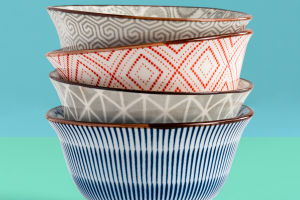Japanese ceramics hold a unique place in the world of art and craftsmanship.
For centuries, Japan has been renowned for its exquisite pottery, which reflects a deep connection with nature, meticulous attention to detail, and a profound appreciation for aesthetics. From functional tea bowls to delicate porcelain creations, Japanese ceramic culture is a testament to the nation's rich heritage and artistic excellence.
Historical Significance:
Japanese ceramic culture has a rich and storied history that dates back thousands of years. The art of pottery was introduced to Japan during the Jomon period (10,000-300 BCE). This period marked the beginning of clay pottery production and witnessed the development of unique techniques like coiling and pit-firing. As time progressed, the Yayoi period (300 BCE - 300 CE) brought advancements in kiln technology and the introduction of new styles and forms.
Regional Diversity:
One of the remarkable aspects of Japanese ceramic culture is its regional diversity. Various kiln sites and pottery centers across the country have their own distinct styles, techniques, and glazes. For instance, the Bizen pottery from Okayama Prefecture is famous for its unglazed, reddish-brown clay and natural wood-fired kilns, while the delicate and refined porcelain of Arita, in Saga Prefecture, is renowned worldwide.
Aesthetic Principles:
Japanese ceramics embody the aesthetic principles of wabi-sabi, which celebrates imperfection, transience, and the beauty of natural materials. This philosophy emphasizes simplicity, asymmetry, and the appreciation of subtle, understated beauty. The concept of "yūgen," meaning profound grace and elegance, is also essential to Japanese ceramic art, emphasizing the emotional and spiritual resonance of a piece.
Traditional Techniques:
Japanese potters employ a range of traditional techniques that have been handed down through generations. Some notable techniques include:
Raku: Developed in the 16th century, Raku ware is known for its irregular shapes, bold glazes, and unique firing process. Each piece is hand-molded, fired in a small kiln, and then rapidly cooled, resulting in crackled glazes and distinctive patterns.
Hagi: Originating from Hagi City in Yamaguchi Prefecture, Hagi ware showcases a rustic and earthy aesthetic. The technique involves layering multiple glazes to achieve soft, muted colors and a unique texture that becomes smoother with use.
Kutani: Originating in Ishikawa Prefecture, Kutani ware is characterized by its vivid colors, intricate designs, and meticulous attention to detail. Artists hand-paint intricate motifs, often featuring nature-inspired themes, using fine brushes and multiple layers of glaze.
Tea Ceremony and Ceramics:
The Japanese tea ceremony, or chanoyu, is deeply intertwined with ceramic culture. Tea masters carefully select tea bowls, known as Dhawan, that reflect the spirit of the ceremony. These bowls are often handcrafted by master potters and can vary in shape, size, and glaze. The tea ceremony's philosophy of mindfulness, harmony, and respect is embodied in the choice and appreciation of ceramic vessels.
Contemporary Ceramic Art:
Japanese ceramic culture is not confined to traditional forms alone. Contemporary ceramic artists continue to push boundaries, incorporating innovative techniques and conceptual approaches. Many artists blend traditional and modern influences, creating stunning works that bridge the gap between the past and the present.
Japanese ceramic culture is a vibrant tapestry woven with artistic brilliance, technical mastery, and profound cultural significance.


